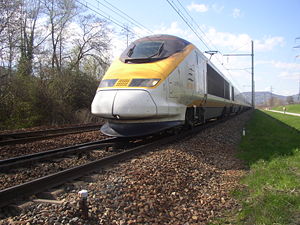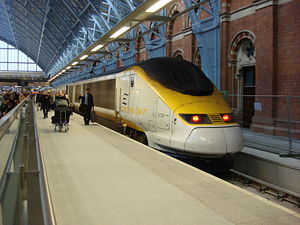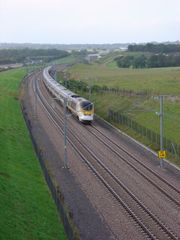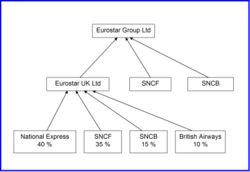Eurostar
2008/9 Schools Wikipedia Selection. Related subjects: Engineering
Eurostar is a train service primarily connecting London and Kent in Britain, with Paris and Lille in France, and Brussels in Belgium. In addition to these three-capitals services, there are limited services from London to Disneyland and several seasonal destinations in France. Trains cross the English Channel through the Channel Tunnel.
The service is operated by a fleet of specially designed eighteen-carriage Class 373 trains which travel at up to 300 km/h (186 mph) on a network of high-speed railway lines. Since the Eurostar service began in 1994, new lines have been built in Belgium ( HSL 1) and Southern England ( High Speed 1) to the same standards as the LGV Nord line originally used in France, enabling journey times to be progressively reduced. The two-stage High Speed 1 project was completed on November 14, 2007, when the London terminus of the Eurostar service transferred from Waterloo International to St Pancras International station.
History
The history of the Eurostar rail service can be traced back to the 1986 choice of a rail tunnel to provide a fixed cross-Channel link between Britain and France. In addition to the tunnel’s shuttle trains, this decision provided for through passenger and freight trains. British Rail and SNCF contracted with Eurotunnel to use half the tunnel’s capacity. In 1987 Britain, France and Belgium set up an International Project Group to create a specification for a train capable of providing an international, high-speed rail service through the Channel Tunnel. Having been operating high speed TGV services since 1981, and with construction of a new high-speed line between Paris and the Channel Tunnel ( LGV Nord) well underway, it was perhaps unsurprising that TGV technology was chosen as the basis for the new trains. An order for thirty trainsets was placed in December 1989.
Testing of the new trains revealed some problems when used on the 750V third rail system in Britain. The trains were designed to shut themselves down if they might be causing electrical interference with the signaling system, and this happened frequently. However, the problems were solved and on 14 November 1994, Eurostar services began between the new Waterloo International station in London, Paris and Brussels. Services to Ashford International followed on 8 January 1996.
Regional Eurostar and Nightstar
Part of the original proposals for Eurostar were direct services to Paris and Brussels from cities north of London (NoL): Manchester (via Birmingham on the West Coast Main Line) and Glasgow (via Edinburgh, Newcastle and York on the East Coast Main Line). Seven shorter NoL Eurostar trains intended for these Regional Eurostar services were built, but with predicted journey times of almost nine hours for Glasgow to Paris, the growth of low-cost air travel during the 1990s made the plans commercially unviable. Three of the Regional Eurostar units were later leased by Great North Eastern Railway (GNER) to increase capacity on domestic services from London King's Cross to York and later Leeds. The leases concluded in December 2005, and most of the NoL sets have since been transferred to SNCF for use on domestic TGV services in northern France.
An international Nightstar sleeper train service was also planned; these would have travelled along the same routes as Regional Eurostar, plus the Great Western Main Line to Cardiff. These were also deemed commercially unviable, and the scheme was abandoned; in 2000 the coaches were sold to VIA Rail in Canada.
New high speed lines
HSL 1
A significant improvement in journey times between London and Brussels occurred when a new Belgian high speed line, HSL 1, was opened on 14 December 1997. A further four-minute improvement for London-Brussels services was achieved in December 2006 with completion of a new 435m long Brussels South Viaduct. Linking the international platforms of Brussels-South railway station with the high speed line, the viaduct separates Eurostar from local services.
High Speed 1
The next major improvement came in September 2003 with the opening of the first section of the British high-speed line between the Channel Tunnel and Fawkham Junction in north Kent. London–Paris journey times were cut by around 21 minutes to 2 hours 35 minutes, and London-Brussels was reduced to 2 hours 20 minutes.
Shortly before the opening of the newly completed high speed line, two special runs took place. On 4 September 2007, a special record-breaking train left Paris Gare du Nord at 10:44 (09:44 BST) and reached London St Pancras in 2 hours 3 minutes 39 seconds. French driver Francis Queret took train-set 3223/24 through France, while Briton Neil Meare took control of the train passing through Kent. Transporting journalists and railway workers, the train was the first passenger-carrying arrival at the new St Pancras International station. The train passed through the new £100 million Ebbsfleet International station near Dartford in Kent on the way to St Pancras; both stations will provide direct services to the site of the 2012 Olympics at Stratford, London.
On 20 September 2007, Eurostar broke another record as it completed the journey from Brussels to London in 1 hour, 43 minutes. The train left Brussels-South Station at 10:05, and reached St Pancras International at 11:48.
From 30 October to early November 2007 Eurostar conducted an Integrated Volume Testing program in which some 6000 members of the public were involved in passenger check-in, immigration control and departure trials, during which the 'passengers' each made three return journeys out of St Pancras to the entrance to the London tunnel.
At 18:12 on 13 November 2007 the last Eurostar service left Waterloo International, and on 14 November commercial services began over the whole of the new High Speed 1 line. The redeveloped St Pancras International station became the new London terminus for all Eurostar services; at a cost of £800 million this has been extensively rebuilt and extended in length to cope with the 394 m (431 yd) Eurostar trains. The first service left St Pancras at 11:06 for Brussels, with the first arrival from the same city pulling in at 11:09. The first train to Paris departed at 11:03.
The completion of High Speed 1 has brought the British part of Eurostar's route up to the same standards as the French and Belgian high-speed lines. Line speeds are 300 km/h, except within the tunnel sections where slower speeds apply for safety reasons. Non-stop journey times have been reduced by a further 20 minutes to 2 hours 15 minutes for London-Paris and 1 hour 51 minutes London-Brussels.
Current routes and services
| Eurostar route map | |||||||||||||||||||||||||||||||||||||||||||||||||||||||||||||||||||||||||||||||||||||||||||||||||||||||||||||||||||||
|---|---|---|---|---|---|---|---|---|---|---|---|---|---|---|---|---|---|---|---|---|---|---|---|---|---|---|---|---|---|---|---|---|---|---|---|---|---|---|---|---|---|---|---|---|---|---|---|---|---|---|---|---|---|---|---|---|---|---|---|---|---|---|---|---|---|---|---|---|---|---|---|---|---|---|---|---|---|---|---|---|---|---|---|---|---|---|---|---|---|---|---|---|---|---|---|---|---|---|---|---|---|---|---|---|---|---|---|---|---|---|---|---|---|---|---|---|---|
|
Legend
Times shown are fastest timetabled journey from London St Pancras. |
|||||||||||||||||||||||||||||||||||||||||||||||||||||||||||||||||||||||||||||||||||||||||||||||||||||||||||||||||||||
Since 14 November 2007 all Eurostar trains have been routed via High Speed 1 from the newly redeveloped London terminus at St Pancras International. Originally Eurostar intended to retain some services at the former Waterloo International terminal, but this was later ruled out on cost grounds.
From 9 December 2007 Eurostar offers 17 weekday London–Paris services (19 on Fridays) including 7 non-stop, and 10 London–Brussels trains including 3 non-stop. In addition to these three-capitals services, there is one round-trip London– Disneyland Paris and two seasonal services: from July to September there is a weekly London–Ashford– Avignon service, and in the winter months there are twice-weekly Snow Train services to Bourg-Saint-Maurice, Aime-la-Plagne and Moutiers in the French Alps for the ski season; one of these runs overnight and the other is a daytime round-trip.
Current intermediate stations are Ebbsfleet International in northwest Kent, Ashford International in southeast Kent, and Calais-Fréthun and Lille-Europe in northern France. However, since the opening of Ebbsfleet International, only three trains a day to Paris and one to Disneyland Paris now stop at Ashford. No Brussels-bound trains now stop at the station, meaning passengers must instead change at Lille for Brussels. Withdrawing services from a station opened only a decade ago has provoked controversy from the local community, but Eurostar has rejected accusations that it is "moth-balling" Ashford International. On 3 April 2007 a petition with 8,000 signatures was taken to London Waterloo calling for an EU enquiry into the impact of the reduced services from Ashford International.
Completion of High Speed 1 has allowed a significant increase in the potential number of Eurostar trains serving London. Capacity now exists for up to eight trains per hour to travel in each direction from London to Continental Europe, moving the bottleneck to the Channel Tunnel itself. Separation of Eurostar from UK domestic railway services through Kent means that its timetabling is now unaffected by peak-hour restrictions.
Eurostar is a member of the Amadeus CRS global distribution system, making its tickets available alongside those of airlines worldwide. From 18 December 2007 through-fares were made available from 68 UK towns and cities to Paris, Brussels and other destinations in France and Belgium.
Operational performance
Eurostar's punctuality has fluctuated over the years of its service, but in 2007 91.5% of services were on time.
Since the first revenue-earning Eurostar trains ran in November 1994, Eurostar has established a dominant share of the combined rail/air market on its principal three-capitals routes. In 2007 it achieved all-time highs of 71% on the London-Paris route and 65% for London-Brussels.
Eurostar's passenger numbers, while substantial, have generally failed to meet the ambitious predictions that have been made. In 1996 LCR forecast that passenger numbers would reach 21.4 million by 2004, but only 7.3 million was achieved. Eurostar's current target is 10 million passengers by 2010.
| 1995 | 1996 | 1997 | 1998 | 1999 | 2000 | 2001 | 2002 | 2003 | 2004 | 2005 | 2006 | 2007 |
|---|---|---|---|---|---|---|---|---|---|---|---|---|
| 3 | 5 | 6 | 6.3 | 6.6 | 7.1 | 6.95 | 6.60 | 6.31 | 7.27 | 7.45 | 7.85 | 8.26 |
All figures in millions. 1995-1998 data is approximate.
A number of factors are likely to support Eurostar's latest growth targets:
- The improvement in the quality of its service in terms of journey times, punctuality and station facilities.
- An increasing awareness of the environmental effects of air travel. Eurostar claims that its service emits considerably less carbon dioxide than a comparable flight, and that its remaining carbon emissions are now offset making its services carbon neutral.
- Expansion of the high speed rail network in Europe (such as HSL-Zuid), bringing more destinations within rail-competitive range.
Rolling stock

Eurostar's main fleet consists of 38 electric multiple unit train, designated Class 373 in the United Kingdom and TGV373000 in France. There are two variants:
- 31 Three Capitals sets which have 18 carriages, are 400 metres long and can carry 750 passengers.
- 7 shorter North of London trains which have 14 carriages and were designed to operate the proposed Regional Eurostar services.
The trains are essentially modified TGV sets and can operate at up to 300 km/h (186 mph) on high-speed lines, and 160 km/h (100 mph) in the Channel Tunnel. Speed limits in the Channel Tunnel are dictated by air-resistance, energy (heat) dissipation and the need to fit in with other trains operating at slower speeds.
The trains were designed with Channel Tunnel safety in mind, and consist of two independent "half-sets", each with its own power car. In the event of a serious fire on board while travelling through the Tunnel, the passengers would be transferred into the undamaged half of the train, which would then be detached from the damaged half and driven out of the tunnel to safety. If the undamaged part were the rear half of the train, this would be driven by the Chef du Train who is a fully authorised driver and occupies the rear driving cab while the train travels through the tunnel for this purpose.
In 2004-2005 the Three Capitals sets still in daily use for international services were refurbished with a new interior designed by Philippe Starck. The old grey-yellow scheme in Standard class and grey-red of First/Premium First were replaced with a new grey-brown look in Standard and grey-burnt orange in First class. Power points were added to seats in First class and coaches 1 and 18 in Standard class. Premium First class was renamed BusinessPremier.
As 27 of the 31 Three Capitals sets are sufficient to operate the service, four are currently used by SNCF for domestic services; one of these regularly operates the Paris-Lille shuttle.
Current fleet
Past fleet
Eurostar has operated a number of other types in the past:
- Class 37 - a diesel locomotive intended to operate sleeper services over non-electrified parts of the railway network in Britain. Eurostar retained three locomotives for the rescue of failed trains, route learning and driver training, but disposed of them when the new Temple Mills Depot opened in November 2007.
- Class 73 - an electro-diesel locomotive used primarily to rescue failed trains. Eurostar operated two of these from its North Pole depot until 2007, when they were loaned to a pair of educational initiatives having become redundant following the move to Temple Mills.
- Class 92 - an electric locomotive intended to operate the sleeper services. Eurostar owned seven units of this class, which never saw service until they were sold in 2007 to Europorte 2.
Future developments
A number of possible future developments affecting the Eurostar service have been mooted:
Services from Stratford International station
The intended purpose of Stratford International station was to act as a London stop for regional Eurostar trains. However this plan is under review and it is unlikely that Eurostar trains will call at the station until 2010 at the earliest.
Regional Eurostar
Although the original plan for Regional Eurostar services to destinations north of London were abandoned, the significantly improved journey times available following the opening of High Speed 1 ---- which has connections to both the East Coast Main Line and North London Line (for the West Coast Main Line) at St Pancras ---- and increased maximum speeds on the West Coast Main Line, may make potential Regional Eurostar services more viable. This would be even more likely if proposals are adopted for a new high speed line from London to the north of Britain.
Key pieces of infrastructure still belong to LCR via their subsidiary London & Continental Stations and Property such as the Manchester International Depot, and Eurostar (UK) still own several track access rights and the rights to paths on both the East Coast and West Coast Main Lines. While no announcement has been made of plans to start Regional Eurostar services, it remains a possibility for the future. In the meantime, the nearest alternative to a Regional Eurostar service is same-station connection with Midland Main Line trains at St Pancras.
Destinations beyond Paris and Brussels
The reduced journey times offered by the opening of High Speed 1 bring other continental destinations within a range from London within which rail is competitive against air travel. At present Eurostar is concentrating on developing its connections with other services, particularly at Lille and Brussels, but direct services to other destinations would be possible.
LGV Picardie
LGV Picardie is a proposed high-speed line running between Paris and Calais, via Amiens. By cutting off the corner of the LGV Nord at Lille, it would enable Eurostar trains to save 20 minutes on the journey between Paris and Calais, bringing the London to Paris journey time under 2 hours.
Competitor services
Deutsche Bahn, Germany's national train company, has applied to use the Channel Tunnel and High Speed 1 rail line into St Pancras International. The service would run on the existing route from London to Brussels, then via the new HSL 3 high speed line to Cologne and other destinations in Germany. One of the major obstacles to such a service is the stringent fire safety regime applying to trains using the Channel Tunnel; this would have to be relaxed, or else new trains would be required.
Organisation
Eurostar services are under unified management, the Eurostar Group. In each country, a member company undertakes Eurostar operation:
- Belgium — NMBS/SNCB
- France — SNCF
- United Kingdom — Eurostar (U.K.) Ltd. or (EUKL)
- EUKL managed (under contract) by InterCapital and Regional Rail (ICRR), a consortium of:
- National Express Group (40%),
- SNCF (35%)
- NMBS/SNCB (15%)
- British Airways (10%).
- EUKL managed (under contract) by InterCapital and Regional Rail (ICRR), a consortium of:
Eurostar is a member of Railteam, a marketing alliance formed in July 2007 of seven European high-speed rail operators, including Thalys. The alliance plans to allow tickets bookable from one side of Europe to the other on one website.




